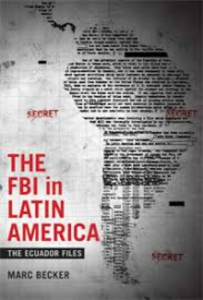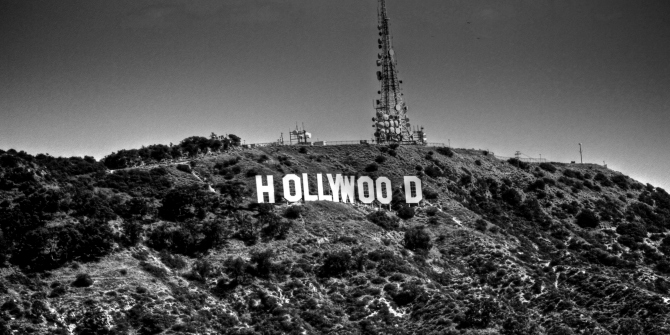In The FBI in Latin America: The Ecuador Files, Marc Becker brings together and analyses an extensive documentary history of FBI, CIA and US State Department intelligence operations in Ecuador. This is an impressively researched and detailed book, writes Courteney J. O’Connor, that gives rich insight into leftist movements in Ecuador and contributes to scholarship on US interference in the internal politics of Latin American nations in the period.
This book review has been translated into Spanish by Camille Duiquet, Moritz Hauschulz and Lia Janzer (Spanish LN785, teacher Esteban Lozano) as part of the LSE Reviews in Translation project, a collaboration between LSE Language Centre and LSE Review of Books. Please scroll down to read this translation or click here.
The FBI in Latin America: The Ecuador Files. Marc Becker. Duke University Press. 2017.
Authored by Marc Becker, The FBI in Latin America: The Ecuador Files utilises an extensive documentary history of intelligence operations in Ecuador to piece together an impressive account of the Latin America left from the Second World War through to the early years of the Cold War.
While American intelligence agencies have gained a significant amount of public exposure over the past few years, this book shows that, particularly in Latin America, US intelligence has been active and conducting extensive operations for many decades. Prior to the creation of the Central Intelligence Agency (CIA) with the 1947 National Security Act, it was the FBI under J. Edgar Hoover that started extending the US intelligence outreach into the Americas in a more organised fashion. According to Becker’s research, while the threat of fascism and Nazism spreading to the USA’s neighbours in Latin America was deemed a sufficient risk to establish an intelligence-collection capacity in the region, Hoover was almost militantly anti-communist, and in fact was more concerned with leftist movements in Latin America than with right-wing, fascist movements. Almost immediately apparent is the impression of American imperialism in Latin America, a theme that continues (though not without substantive evidence) throughout the text.
The initial FBI intelligence programme in Ecuador was hardly well-funded, well-organised or well-handled. The Special Intelligence Service (SIS) programme was classified, to the extent that few of the agents sworn into it could accurately tell you what it was; most of those sent to Latin America had little to no language skills with which to carry out their work and hardly any idea why they were in Ecuador in the first place. Regardless, these nascent intelligence operatives were soon collecting information (rather ham-handedly at first) on Ecuadorian political groups and activists. Becker points out that, regardless of the initial motive, diplomatic interest in a country rarely remains purely political, and the economic intelligence coming out of Ecuador resulted in sustained US economic interests that were heavily protested by the leftists (31), such as American airline services, postal services and the import of Ecuadorian raw materials. Becker’s research also shows how involved some of the FBI agents became in Ecuadorian policy and law: when posted to the local embassy, at certain points the FBI legal attachés were even drafting ‘decrees and other formal documents for local officials to sign’ (41).
What is communicated clearly throughout the book is that despite Hoover’s claims and posturing to the contrary, communism was never a true risk to US interests in Ecuador. Moreover, while the initial justification for an intelligence apparatus in Ecuador was the suspected presence of Axis influence, this reason was minimal and always took a backseat to Hoover’s obsession with communist activity. This meant that, despite the majority of in-country files being destroyed during the intelligence handover from the FBI to the CIA in the mid-to-late 1940s, there is an extensive documentary record of leftism both in Ecuador and in Latin America generally. These records have helped to piece together not only Becker’s research for this text, but the history of the left in Latin America in general. Many of the sources of which Becker made use are not freely available in Ecuador, so rather inadvertently the FBI performed a commendable service in recording so much information. Nonetheless, an important point about the FBI intelligence-gathering practice made in Chapter Two is that the information gathered is a product of gender bias: the agents were white, male and of moderately privileged backgrounds. Their collection activities tended to focus on male activists, and so little information was ever gathered about women, Indigenous activists, Afro-Indigenous people or rural individuals. As such, even this text on the history of the left in Ecuador does not contain a fully balanced view, though this is through no fault of the author.
One of the themes that also threads through the entire text is the lack of cohesion of leftist movements in Ecuador. Despite there being two main leftist political parties—the Communist Party of Ecuador (PCE) and the Socialist Party of Ecuador (PSE)—as well as other minor left-aligned organisations and labour movements, their lack of cohesive vision or ability to cooperate for extended periods of time fractured the potential of the Ecuadorian left to truly instigate lasting structural change in Ecuadorian government and politics. In addition, even after the communists gained a certain amount of political influence after the May 1944 revolution (‘La Gloriosa’), they did not have the political knowledge or experience necessary to capitalise upon it, resulting in a concentration of skills and resources in the area of constitutional and legislative change but a stultification of party membership as recruitment fell by the wayside. Accordingly, despite communist and socialist support of La Gloriosa, the government eventually swayed to the right once more and the left fell out of all favour and influence once again.
By the 1947 coup that overthrew President Velasco Ibarra (put into power by La Gloriosa), however, the FBI had destroyed most of their records and handed over what was left to the nascent CIA and the already-established State Department. As such, surveillance of the political left in Ecuador continued, and eventually grew further. Recent events such as the Wikileaks releases have illustrated both the extensive efforts and the institutionalised nature of US intelligence operations internationally, despite a technical policy of non-interference (codified, in fact, in the United Nations Charter).
Becker has done extensive research for this book, and his close examination and analysis of the documentary record left behind by FBI, CIA and State Department surveillance of Ecuador are both apparent and appreciated. The attention to detail and the way he has woven together this history of the left are impressive; despite shortcomings in the documentary record, he has presented multiple perspectives, including those of Indigenous groups and of women, though by necessity to a lesser extent. Becker makes it clear throughout the text that he considers the actions of the United States in Latin America imperial in nature, and in some cases paternalistic. Their interference in internal politics is viewed as an attempt to draw the Latin American nations into the US sphere of economic and political influence, and Becker has distinguished a legacy relationship between these efforts and the stilted, inefficient structures of Latin American economies and production capacities in the current age. This is an interesting, well-researched text and I commend the author for the work involved.
Note: This review gives the views of the author, and not the position of the LSE Review of Books blog, or of the London School of Economics.
Image Credit: (Dave Newman CC BY 2.0).
En El FBI en América Latina: los Documentos de Ecuador, Marc Becker reúne y analiza una extensiva historia documental del FBI, la CIA y el departamento de Estado estadounidense sobre los servicios de información en Ecuador. Este es un impresionantemente investigado y detallado libro, escribe Courteney J. O’Connor, que ofrece una notable visión de los movimientos izquierdistas en Ecuador y contribuye a la erudición de las injerencias de Estados Unidos en la política interior de los países América latino en el periodo.
El FBI en América Latina: Los Archivos de Ecuador. Marc Becker. Duke University Press. 2017.
 Review translated by Camille Duiquet, Moritz Hauschulz and Lia Janzer (Spanish LN785, teacher Esteban Lozano).
Review translated by Camille Duiquet, Moritz Hauschulz and Lia Janzer (Spanish LN785, teacher Esteban Lozano).
Escrito por Marc Becker, El FBI en América Latina; Los Documentos de Ecuador utiliza una extensiva historia documental de operaciones de información en Ecuador para juntar una impresionante presentación de la izquierda de América Latina desde la Segunda Guerra Mundial a los primeros años de la Guerra Fría.
Mientras que los servicios de inteligencia estadounidense se han beneficiado de una cantidad importante de exposición pública en los últimos años, este libro muestra que, particularmente en América Latina, la inteligencia estadounidense ha trabajado activamente y ha conducido operaciones durante muchos decenios. Antes de la creación de la Agencia Central de Inteligencia con la Ley de seguridad de 1947, fue el FBI bajo J. Edgar Hoover el que empezó ya a ampliar la extensión de los servicios de inteligencia estadounidense en las Américas de manera más organizada. Según la investigación de Becker, mientras que la amenaza del fascismo y nazismo se extendía a los vecinos de EE.UU. en América Latina, esto se consideró de suficiente riesgo para establecer una capacidad de recopilación de inteligencia en la región. Hoover era casi militantemente anticomunista, y en realidad estaba más preocupado con movimientos de izquierdas en América Latina que de derecha o movimientos fascistas. La impresión del imperialismo americano en América Latina es casi inmediatamente aparente, un tema que continua (aunque no sin pruebas sustanciales) a lo largo del texto.
El programa inicial de inteligencia del FBI en Ecuador fue escasamente bien fundado, bien organizado o bien manejado. El programa de los servicios especiales de inteligencia (SIS) estaba clasificado, hasta el punto de que pocos agentes que prestaron juramento podían decir exactamente de que se trataba; la mayoría de los enviados a América Latina tenía pocas o ninguna habilidad lingüística para realizar su trabajo y habían afirmado desconocer los motivos por los que fueron a Ecuador en primer lugar. Independientemente de eso, estos incipientes operativos de inteligencia fueron pronto recogiendo información, (de una manera más bien torpe al principio) sobre los grupos políticos ecuatorianos y activistas. Becker señala que, independientemente del motivo inicial, el interés diplomático en un país raramente permanece político, y la inteligencia económica que salía de Ecuador resultó en sostenidos intereses económicos para los EE.UU. que fueron protestados por los izquierdistas (31), como los servicios de compañías aérea estadounidenses, los servicios postales y la importación de materias primas ecuatorianas. Además, la investigación de Becker muestra cuán implicado se volvieron los agentes del FBI en las políticas y el derecho de Ecuador: enviados a la embajada local, los agregados jurídicos del FBI a veces incluso redactaban “decretos y otros documentos formales para que los firmaran oficiales locales” (41).
 Image Credit: (Dave Newman CC BY 2.0)
Image Credit: (Dave Newman CC BY 2.0)
Lo que es comunicado claramente por todas las partes del libro es que, a pesar de las afirmaciones de Hoover y su postura en favor de lo contrario, el comunismo nunca fue un riesgo real a los intereses estadounidenses en Ecuador. Además, mientras al principio la justificación para un aparato de inteligencia en Ecuador era la sospechada presencia de influencia de las potencias del eje, esté razón era mínima y siempre ocupaba un lugar secundario en relación con la obsesión de Hoover con actividades comunistas. Esto implicó que, aunque la mayoría de los archivos del país fueron destruidos durante la entrega de inteligencia del FBI a la CIA a mediados y finales de los años cuarenta, existe una relación documental extensiva de izquierdismo, tanto en Ecuador como en América Latina en general. Esos documentos ayudaron a componer no solo la investigación de Becker para este texto sino también la historia de la izquierda en América Latina en general. Considerando que muchas de las fuentes que usaba Becker no están libremente disponibles en Ecuador, en cierto modo el FBI hice un servicio recomendable recolectando tanta información. No obstante, una cuestión importante tratada en el capítulo dos es que la información reunida es un resultado de sesgo de género: los agentes eran blancos, masculinos y de antecedentes moderadamente privilegiados. Sus actividades de recopilación tendían a centrarse en activistas masculinos y de este modo poca información fue reunida sobre mujeres, activistas indígenas, gente afro-indígena o individuos del campo. Propiamente dicho, incluso este texto sobre la historia de la izquierda en Ecuador no contiene una perspectiva totalmente equilibrada, aunque eso no es culpa del autor.
Un de los asuntos que se extiende por todas partes del texto es la falta de cohesión de movimientos izquierdistas en Ecuador. A pesar de la existencia de dos partidos políticos principales – Partido Comunista de Ecuador (PCE) y el partido socialista ecuatoriano (PSE) – así como otras organizaciones y movimientos laborales menores y alineados con la izquierda, su falta de visión cohesiva o habilidad de cooperar durante periodos extensos fracturaron el potencial de la izquierda ecuatoriana para genuinamente iniciar un cambio estructural duradero en el gobierno y en la política de Ecuador. Asimismo, incluso después de que ganaran cierto nivel de influencia política después de la revolución de mayo de 1944 (“La Gloriosa”), ellos no tenían el saber o la experiencia político para capitalizarlo, resultando en una concentración de capacidades y recursos en el ámbito de cambio constitucional y legislativo, pero también en una desvalorización de afiliación al partido cuando el reclutamiento fue dejado de lado. Por consiguiente, a pesar del apoyo socialista y comunista por La Gloriosa, con el tiempo el gobierno comenzó a moverse a la derecha una vez más y la izquierda perdía el favor y su influencia.
Sin embargo, en el momento del golpe de estado que derrocó el Presidente Velasco Ibarra (que obtuvo su poder gracias a La Gloriosa), el FBI había destruido la mayoría de sus archivos y había dado el resto a la naciente CIA y el Departamento de Estado ya establecido. Por lo tanto, la vigilancia de la izquierda política en Ecuador continuaba, y con el tiempo se expandía. Eventos recientes como el lanzamiento de WikiLeaks ilustran los grandes esfuerzos y la cualidad institucionalizada de las operaciones de inteligencia estadounidense alrededor del mundo, a pesar del reglamento técnico que prohibía la interferencia (de hecho, codificado en la Carta de Naciones Unidas.)
Becker ha realizado una exhaustiva investigación para este libro, y su examinación y análisis de los registros documentarios que el FBI, la CIA, y el Departamento de Estado dejaron atrás con respecto a la vigilancia de Ecuador son claros y apreciados. Los detalles y su manera de contar la historia de la izquierda son impresionantes; a pesar de las deficiencias del registro documental, él presenta varias perspectivas, incluso las de los grupos indígenas y las mujeres, aunque por necesidad en menor medida. Becker aclara a través del texto que él cree que las acciones de los Estados Unidos eran imperialistas y a veces paternalistas. La interferencia en la política interna se considera un intento de alinear las naciones de Latinoamérica con la esfera de influencia económica y política estadounidense, y Becker ha distinguido un legado de relación entre estos esfuerzos y las estructuras ineficientes de las economías y capacidades de producción latinoamericanas en la era actual. El libro es un texto interesante, bien investigado, y elogio al autor por su trabajo.
Courteney J. O’Connor es hace el doctorado en la Escuela de Seguridad Nacional de la Universidad Nacional de Australia. Su investigación considera la titularización del ciberespacio y el desarrollo de la política y práctica de contrainteligencia cibernética. Leer más por Courteney J. O’Connor.
Nota: Esta reseña ofrece las opiniones del autor, y no la posición del blog LSE Review of Books, o de la London School of Economics.








2 Comments